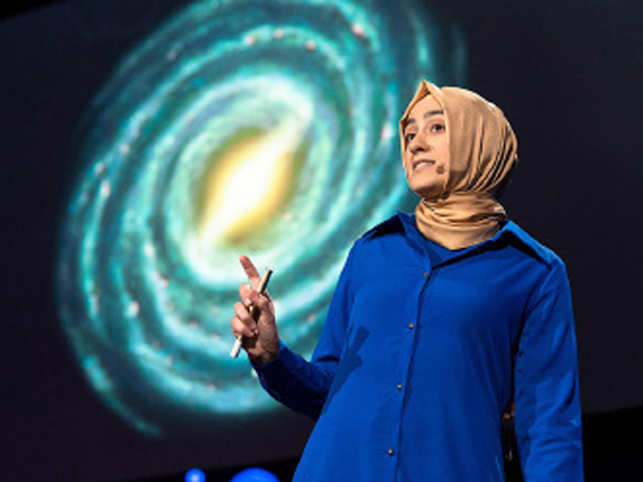- Because of her achievement, Mutlu-Pakdil was named in the ‘2018 Ten Outstanding Young Persons of the World – Academic Leadership and Accomplishment’
- Her work provides the first description of a double-ringed elliptical galaxy, challenging current theories and assumptions about how the universe works and how galaxies start and evolve
ANKARA – Islam encourages its believers to explore the cosmos and its wonders which were created by Allah. “Do they not look at the sky above them, how We have built it and adorned it, and there are no rifts in it.” (Surat Qaf: 50:6).
In light of these Islamic teachings, Muslim always excelled in the scientific fields which explore the universe like astronomy.
Like her medieval Muslim counterpart astronomers, the hijabi Turkish Muslim astrophysicist Burçin Mutlu-Pakdil shares her name with a rare double ring of stars at 359 million light-years away from us.
As a child, Mutlu-Pakdil’s passion for astronomy started by enjoying looking up at the stars in the night sky.
“Even though my family supported my decision and encouraged me to follow my passion, friends and relatives said that girls shouldn’t leave home to study,” she said.

Start of Star
The Muslim astrophysicist attended Beşiktaş Atatürk Anatolian High School and was the first generation of her family to attend college. She completed her undergraduate studies at Bilkent University, Ankara in 2009.
Mutlu-Pakdil then moved to Texas Tech University, the US for her graduate studies, gaining a Master’s degree in 2012.
In continuous progress and steady steps, she earned her Ph.D. last year for “Testing supermassive black hole scaling relations using cosmological simulations and optical/near-IR imaging data” from the University of Minnesota.
She was also appointed a Postdoctoral Research Associate at the University of Arizona. Now, she works at the Steward Observatory looking at the structure and dynamics of astrophysical objects, including dwarf galaxies, galactic rings, and supermassive black holes.
During her doctoral studies, Mutlu-Pakdil discovered the galaxy PGC 1000714, which has been nicknamed “Burçin’s galaxy”. The discovered celestial structure is an extremely rare double ringed elliptical galaxy.
Because of her achievement, Mutlu-Pakdil was named in the ‘2018 Ten Outstanding Young Persons of the World – Academic Leadership and Accomplishment’.
Last year she also received the ‘2017 Ten Outstanding Young Persons, Turkey – Scientific Leadership’ Award. She also won the ‘2017 APS Woman Physicist of July’, and the ‘Linda Larson Woman’ of 2017.
Why Important?
There are about a trillion or so known galaxies in the universe, most of which are spirals like our home galaxy, the Milky Way.
Dr. Mutlu-Pakdil’s work provides the first description of a double-ringed elliptical galaxy, challenging current theories and assumptions about how the universe works and how galaxies start and evolve.
When Mutlu-Pakdil and her team first took note of the little galaxy PGC 1000714, they mistook it as a rare Hoag-type galaxy, and they were pretty excited by their discovery. But when Mutlu-Pakdil studied the galaxy further, she was astounded to find that the unusual galaxy had more secrets to reveal.
“In between the blue outer ring and the red central core, we found a diffused red-colored inner ring surrounding the central body,” she says. “We were looking at a galaxy that had never been seen before.”
This celestial body is now providing astronomers with an intriguing mystery. As with Hoag-type galaxies, the red central core is older than the blue outer ring. But in Burçin’s galaxy, the extra inner ring is the oldest of the lot, indicating that it formed first.
